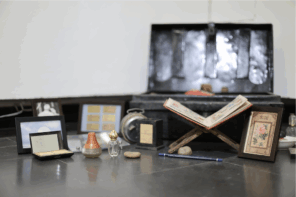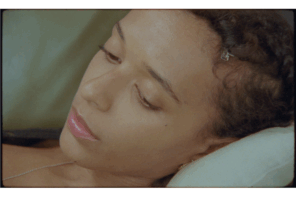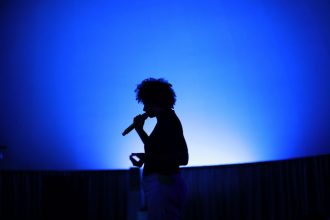Like exotic flowers, international art exhibitions bloom in Berlin, Kassel, and Münster every two, five, or ten years, helping to establish Germany, alongside Venice, Sao Paolo, and Basel, as a vital stop on the contemporary art circuit. This year, for the third time, the exhibition Made in Germany follows documenta’s cycle, showing across three institutions in Hannover: the Sprengel Museum, Kunstverein, and Kestner Gesellschaft.
So why, amid the overwhelming variety of international events on offer, should art enthusiasts get off the train in Hannover this summer? Made in Germany hopes to distinguish itself by rejecting the exoticism of other exhibitions, instead positioning the national as its foundational concept. Because contemporary art in Germany relies heavily on federal, regional, and municipal funding bodies, this is probably a good strategy to appease local patrons and press, for whom art’s internationalism has become something of a lightning rod. But the brand “Contemporary Art” undeniably has a lot in common with the industrial trademark “Made in Germany:” its appeal and mode of production is thoroughly global. Just as a Volkswagen is now known simply as “Das Auto,” so contemporary art distinguishes itself among other types of creative output by bearing almost no marker of its locality (not least because its language, without question, is English). This tension made for an interesting press conference, as the exhibition opened on June 1st:
“Is this Made in Germany or is it Made in Berlin?” one journalist asked, referring to the heavy representation of Berlin-based artists and galleries, and Berlin being, famously, not quite Germany. Another wanted to know: “How German is this exhibition, actually?” How German could it possibly be?
“We see Germany merely as a production area,” one curator responded, “a space within which art is created.” “Besides,” another added, “no artist I know identifies with representing their country.” Fair enough – but the raison d’être of the exhibition undeniably begins to loosen.
Between the national as both qualifier and impossibility, what holds Made in Germany together? The theme for the current iteration, “Production,” helps to support the frail thematic framework by allowing the title to refer to conditions of production in general, as well as their national provenance. In the foyer of the Sprengel Museum, various gestures to this end intersect between the works of Hito Steyerl, Calla Henkel & Max Pitegoff, and Kasia Fudakowski.
Steyerl’s The Empty Centre (1998) bears a lot of weight in grounding the room, both geographically and historically. This early work depicts protests against poor labor conditions during the rebuilding of central Berlin after reunification, demonstrating a commitment to the particular that is mostly absent elsewhere in the exhibition. In their work Machine Prototype I (2017), Henkel & Pitegoff take Allan Sekula’s 1974 photo series This Ain’t China – which portrays a restaurant worker strike in California – as the model for a play set in a Berlin café. Script and photographs rotate on a printing press-like machine as a kind of dislocated cyclical performance. It ain’t China: nor is it California. It’s Berlin, the artists American, and the café a favorite of the ex-pat art set. In the space between Steyerl’s video and Henkel & Pitegoff’s play, territory has already become radically fragmented.
Flanking these works, Fudakoswki’s impressive weave, Working Title: The Worry Wall (2017), simultaneously engages and undermines problems pertaining to the working conditions of artists. The wall piece is accompanied by a digital diary chronicling the various worries the artist experienced while creating the work: the collaborative process of making the weave, the artist’s insecurities about the strength of the concept, etc. Like Prototype I, The Worry Wall does not emerge from a stable socio-geographical context – so it has none to comment on. Instead, the diary, oscillating between self-criticality and irony, renders Fudakowski’s personal experience of working as an artist a pale proxy for the broader reality of labor. In the end, the territory she refers to is the rather abstruse one of the artworld.
Perhaps the landscape of contemporary art is better mapped relationally than geographically. As testament to their influence as teachers, each institution includes a senior practitioner on the list of artists otherwise all born in the 1980s: Hito Steyerl at Berlin’s Universität der Künste; Willem de Rooij at Frankfurt’s Städelschule,;and Thomas Ruff, who previously taught in Düsseldorf. Between them, the idea of Germany as a “production area” emerges as metaphor: a network of institutions and the chains of influence that it generates. At the Kunstverein, a room is also dedicated to the Berlin Program for Artists, presenting a shifting constellation of artists throughout the summer. In these respects, it’s easy to follow the curator’s point: the locality of production is not an attribute that settles on the surface of the works. It’s manifested in the relations that form around them as they’re made.
However, Germany’s network of affiliations is imbedded within a larger cosmopolitan one, on which individual institutions depend for their esteem. This is the strength of Germany in the globalized artworld, as well as the strength of contemporary art as a concept in itself. But does this emerge as a national characteristic? To illustrate this tension, we can look to the dispute around the intendancy of former Tate director Chris Dercon at Berlin’s esteemed Volksbühne theater. This stage, perhaps more than any other in the country, represents an art form thought to be particularly German. In an ongoing, heated debate, Dercon, an avatar of high-powered English-speaking contemporary art, is seen to threaten this rare, locally precious, and, in the case of Volksbühne, largely socialist, German-speaking theater tradition. The positions are entrenched: on the one hand, internationalism is equated with neoliberalism and bland cosmopolitanism, while on the other, Dercon’s critics are charged with nationalism, and pitted against post-colonial, queer, and anti-border discourses. Is it possible to insist on local difference without being nationalist? Can the International Art Circus arrive without homogenizing the face of culture and precaritizing the local workforce?
In the Volksbühne debacle, contemporary art is cast as a colonizing force advancing on other cultural spheres. But more germane to the Hannover exhibition is whether nationality within art production has lost its significance as anything other than a funding model, or, put differently, whether the ”German-ness” of an artist can tell us anything about Germany, beyond testifying to the competency of its cultural infrastructure. This, again, comes down to the supranational stage on which the matrix of contemporary art institutions and events operate. In this, the problem of art’s descending on a given place may extend from the discussions around documenta and other various biennials, to include its daily presence everywhere. Whether this rootlessness is necessarily, or at all, a bad thing, is a separate question, but we might begin to think about what it does to our perspective as practitioners, and how it affects contemporary art as a reflection of the aesthetic, social, and political developments specific to any location.
The strengths of contemporary art lie rather in considering globalization, urbanism, technology, identity production, and migration, which many of the Made in Germany works do very well. Amy Lien & Enzo Camacho’s installation at the Kestner Gesellschaft combines references to the Chinese artist Chen Shaoxiong with video clips from a Frank Stella retrospective at Kunstmuseum Wolfsburg, and audio from Werner Schroeter’s film Palermo oder Wolfsburg (1980) about an Italian worker at the Volkswagen factory. Titled oder, the work suggests neither Wolfsburg nor Palermo, but offers instead the impossibility of any one place, laying bare the multifarious composition of all cultural objects.
The role of Wolfsburg – which neighbors Hannover – in oder is typical of commissioned works, artists often having been invited to “respond” to the local area of a given institution. While Lien & Camacho do this by bringing the world to Wolfsburg (or rather highlighting the way in which it is already there), many works engage their more immediate surroundings. Schirin Kretschmann, for instance, has placed the opaque glass plates from the skylight of the Kunstverein on the floor, and covered them with a fine layer of powdered blue pigment. Titled Physical (2017), it’s totally stunning, subtly bringing our attention to the architecture of the room – as it would in almost any other space. Here, the site-specific work is a gesture at compensating for art’s generally deterritorialized mode of production, only the site becomes so specific it’s completely interchangeable.
In the end, this is what Made in Germany tells us: nothing about what it means to be German, or non-German in Germany, or how global concerns make themselves known here. Rather, it successfully demonstrates that its art academies can produce, its galleries nurture, and its cities attract art of such a high quality that it could be –in fact is – from anywhere. German art, like a Volkswagen, known simply as Die Kunst.

























